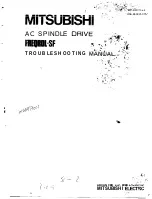
25
Rev. 1.0
0006302011
SSM24C User Manual
+86-400-820-9661
one ounce-inch of torque were applied to the motor, it would move at a slower speed. The VP term
will increase the motor torque until it is producing as much torque as the force attempting to move
it. The motor may slow down or even stop moving but there will still be error. The VI term adds up
all the error the velocity calculation has reported and produces a torque that is added to the torque
command from the VP term. The equation for this is:
T = VP * Vn + VI∑(V)
In the example, the VP term allowed the motor to reach equilibrium at a speed where the applied
torque equaled the torque of the VP term. Thus, the error was not zero. But the VI term continues
adding up the error and increasing the torque until the motor returns to the true target position.
5.1.3 FF Gain: Acceleration Feed-forward Term (KK)
Larger loads typically generate larger load Inertia. These larger inertias can be more easily
controlled by anticipating the system’s torque need. The Acceleration Feed-forward term does this
by adding an acceleration value to the Torque command. The acceleration value is derived from
the Trajectory Calculation during the acceleration and deceleration phase. As can be seen in the
equation below this increased Torque command is added with the VP and VI torque command
values:
T = KK * A + VP * Vn + VI∑(V)
5.1.4 PID Filter: Torque Command Filter Term
(KC)
This fi nal term in the Velocity control loop can be
considered an over-all fi lter term. In fact this term is
always used even when the drive has been placed in
the Torque Control Mode where only the Current control
loop is active. The fi lter is a very simple single-pole
low pass fi lter that is used to limit the high frequency
response of the Velocity and therefore the Position
control loops.
5.2 Position Control Loop
Position Loop
Velocity Loop
Current Loop
















































